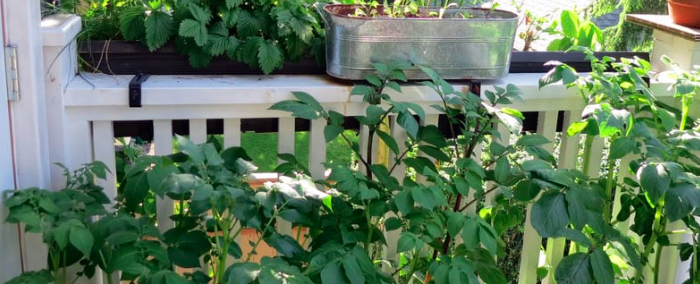
By dint of seeing pretty images of generous vegetable gardens in very small spaces on Pinterest or Instagram , you say you perhaps: “And if I did my first kitchen garden balcony? It does not seem so complicated after all. “
We have bad news and a good one! The bad: if we made a ratio ( effort of installation and maintenance) / ( generosity of the harvest), the kitchen gardens of balconies would be surely classified last. Why ? Because most of the conditions to grow easily are absent on an urban balcony, apart from the light. The good: gardening is trying , being wrong, and sometimes we have good surprises !
Groww gives you some tips on whether your balcony is suitable for growing, and how to develop it.
Is my balcony suitable for cultivation?
Check the orientation.
First, if your balcony is in the shade all day long , we hope you like lettuce and radishes, because that may be the main part of your production.
Then, for the balconies exposed to the east, you are lucky because your plantations will have a rather soft light in the morning, without the hot weather of the afternoon.
Finally for balconies facing south and west, water management will be more complicated. Indeed your plants will undergo the hot weather, strong temperature differences, and will require more watering.
Beware of the wind.
You may think innocently that rain falls everywhere … and no, areas near the walls and sheltered from prevailing winds may never receive water . Consider this if you are installing a structure against a wall, because if it never rains on it, you will not be able to go on vacation anymore.
Another essential point about the wind is that if your balcony is in a draft, your plants will dry very quickly. Sometimes so much that it should be watered several times a day. The installation of windbreaks can help but it also bites light, so go slow.
How to avoid too frequent watering?
The one who answers me “by an automatic watering” goes to the corner 😉 It is a possible solution … but not frankly ecological .
Water shortages are often due to irregular inflows rather than a general shortage throughout the year.
It is necessary to obtain a certain “inertia”, to manage to store the water when it rains a lot and to leave it available to the plants when it is drier. The most effective is to have very deep containers, and mulching on the surface.
NB for seedlings and young seedlings, always keep the wet surface soil permanently. So during this period no matter the size of the pot, it is necessary to water often.
What is the best way to plant your balcony garden?
We will not talk about potato tricks . No. Useless to insist. Potatoes, for us, it’s under cover , and that’s all.
Bac or pots, same fight: the important thing is the volume and especially the depth . We particularly like pots with integrated water reserve.
Choosing containers according to their look is especially good at the time of the photo.
It’s so cute to have lots of small recycling containers attached to DIY wooden structures. Except when you have to water them twice a day because they are too small 😉 Not to mention the plants that drown in the pretty vintage cups at the first heavy rain because they are not drilled in the bottom .
The subject of the size and nature of containers has already been discussed here .
So the look is good but always check two essential criteria: plan big, and always well drained !
And a structure is good or is it gadget?
In the balcony, one often has a lot of height and little surface. So the wooden structures to install several pots in front of a sunny wall, it’s really clever . Obviously, a standard shelf is unsuitable, but those that are inclined are perfect. They just have to be strong !
And pollution?
Ask yourself seriously. A kitchen garden balcony above a busy street is polluted by exhaust dust . We strongly advise against growing within 5 meters of a busy road. The question is not insignificant, because if one seeks to produce one’s own vegetables, it is among other things to ensure their quality .
Attention too! The structures of recovery is great, we often see them made with pallets. But do you know what treatments are used for the wood used to make them? Usually, to increase the durability of the wood outside, it is sent under pressure a mixture of fungicides . Better to avoid eating, so do not grow with soil directly directly in contact with wood.
My vegetables are not very tasty, why?
Many factors affect the flavor of vegetables and aromatic herbs, and to a large extent it is the choice of varieties. For example, hybrid varieties grow so fast that the soil can not keep up. So their nutrient concentration is lower at equal volume.
But in any case, even with stabilized varieties, do not expect a miracle of taste .
Contrary to what the afficionados of above-ground cultivation want to make believe, vegetables are not content with only water and fertilizers based on nitrogen, potassium and phosphorus – NPKs. To have a good taste value, they need rare minerals that are not easily found in the soil: boron, cobalt, nickel, selenium, vanadium, chromium, etc. To obtain them, you need a real soil . Living, with organic matterand mineral compounds to degrade.
Good project, and good gardening!